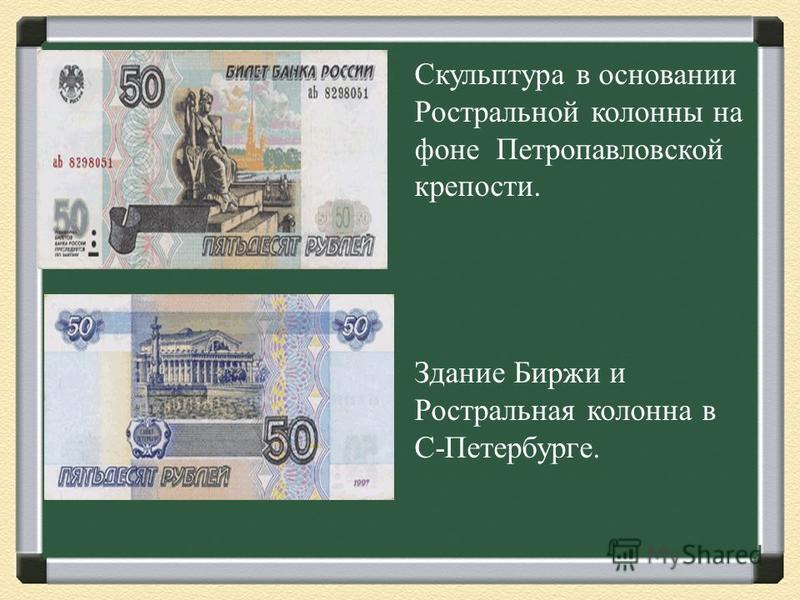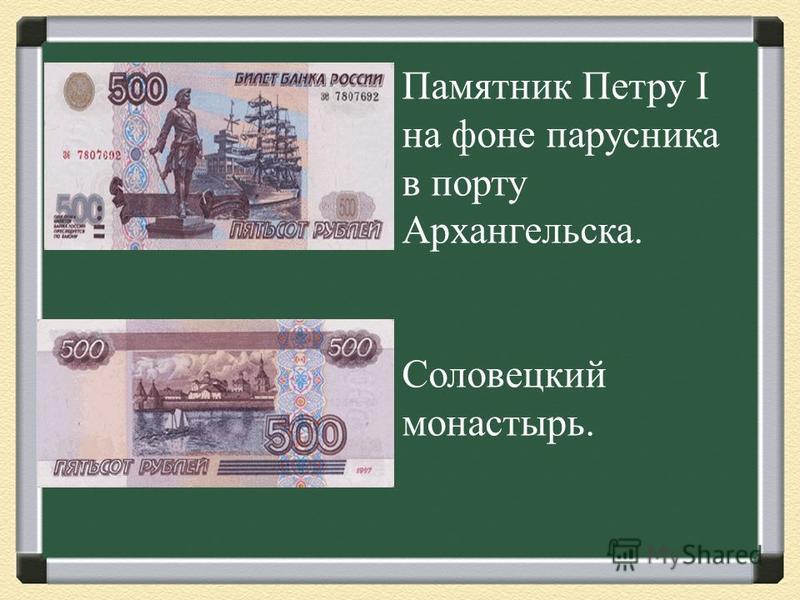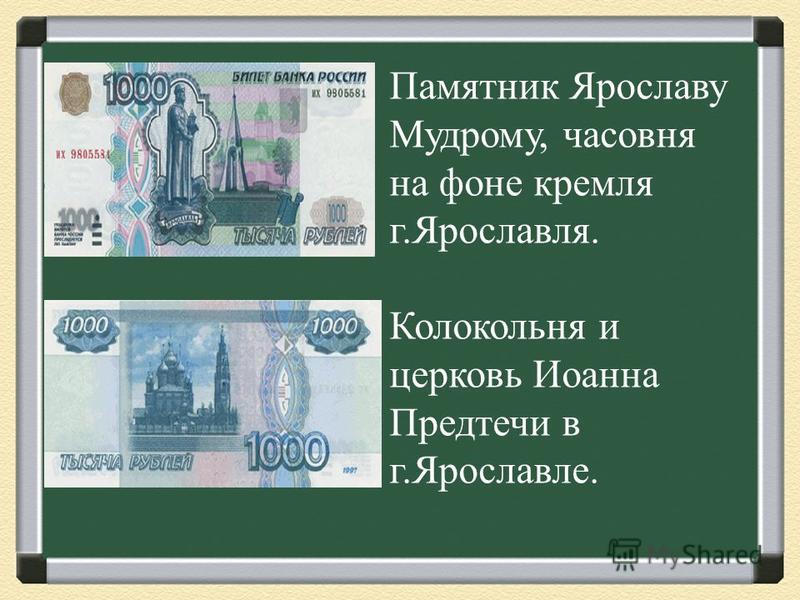The origin of the word "money" in Russian Tamga TengaDenga DengaMoney The word "tamga" is translated into Russian as a "sign", "stamp". On its basis, the name of the coin "tenge" arose. Denga (in Tatar “ringing”) was called only one coin until the 19th century.

The need for money Money is a tool for managing the life of an individual and society as a whole. Money fetishism has a much stronger influence on the individual and social psychology of people, and hence its negative and positive influence on people's behavior, their destinies and social processes.

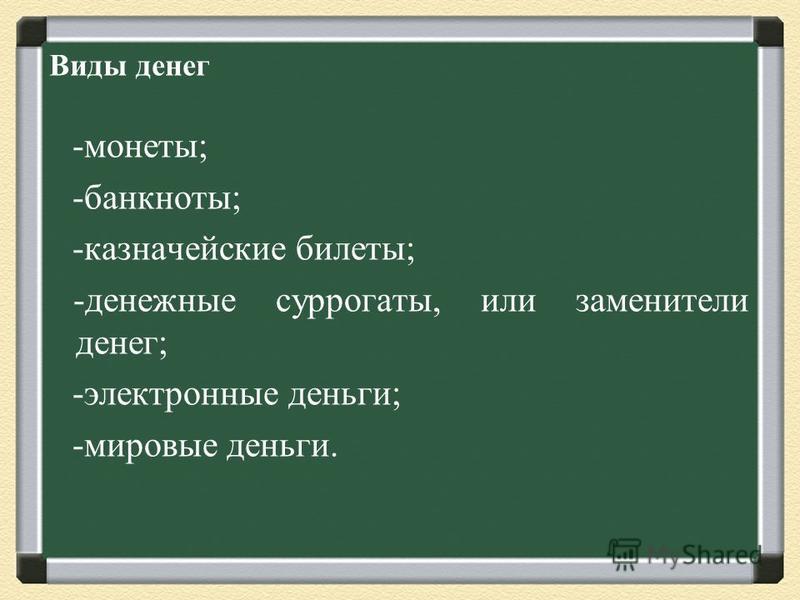
Primitive forms of the first money: 1 - cowrie shells (mollusks); 2 - pearl pendants; 3 - a bunch of money-shells; 4 - a bunch of metal money-rings; 5 - iron hoe; 6 - bronze hatchet; 7 - iron bars from the temple of Hera in Argos; 8 - iron ingot from Britain; 9 - golden disc from Mycenae; 10 - bronze ingot from Mycenae; 11 - copper ingot from Italy; 12 - Roman ingot with brand.
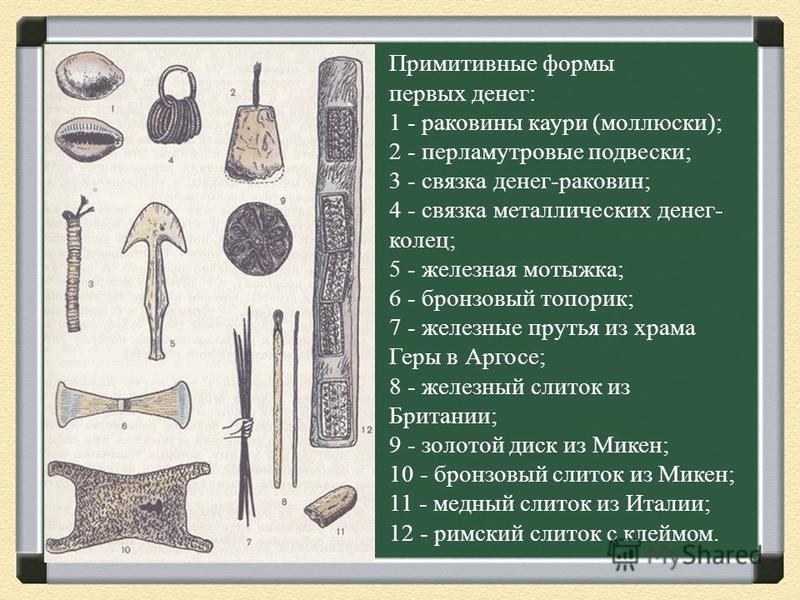
Interesting Facts About Money Cattle are probably the oldest form of money. In some parts of Africa, it was used in this capacity until the middle of the 20th century. In Burma, until the 20th century, salt and brick tea were used as money. In Mexico, bags of cocoa beans. Money in different countries were: tobacco, dried fish, grains of rice, corn. In Melanesia, bundles of dog teeth and shells acted as money.
Interesting facts about money During the period of inflation in the early 20s of the 20th century, porcelain coins were issued in Germany, which, however, had a very short period of circulation. Porcelain coins were used in Thailand in the early 18th century. In the 13th century, salt money was widely used in Tibet - a kind of "natural money", which was sticks or pieces of salt with a special stamp that guaranteed the quality and weight of the salt.
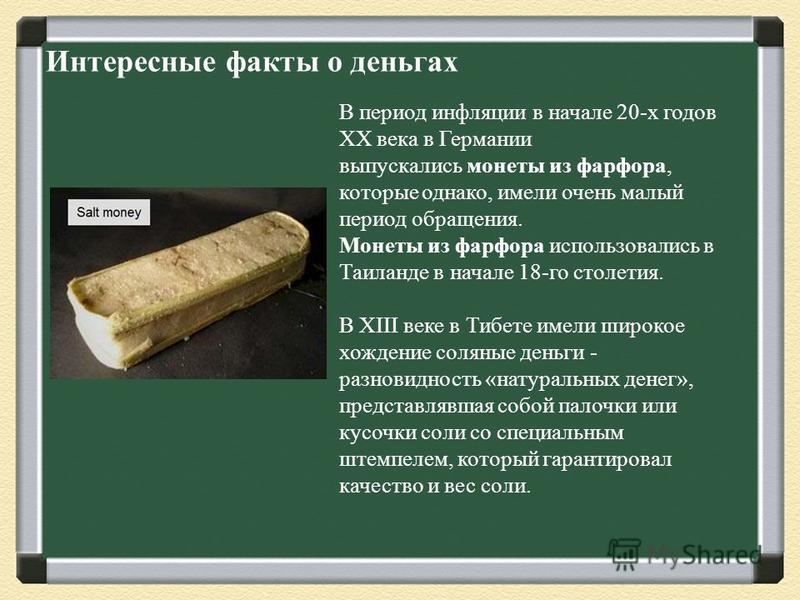
Interesting facts about money In China, many centuries ago, standard pieces of silk served as money. The first paper money appeared in China in 812 AD. Banknotes made of polymer plastic are now in use in Australia, Brazil, Malaysia, Thailand and other countries. The most popular banknote in the world is 500 euros.
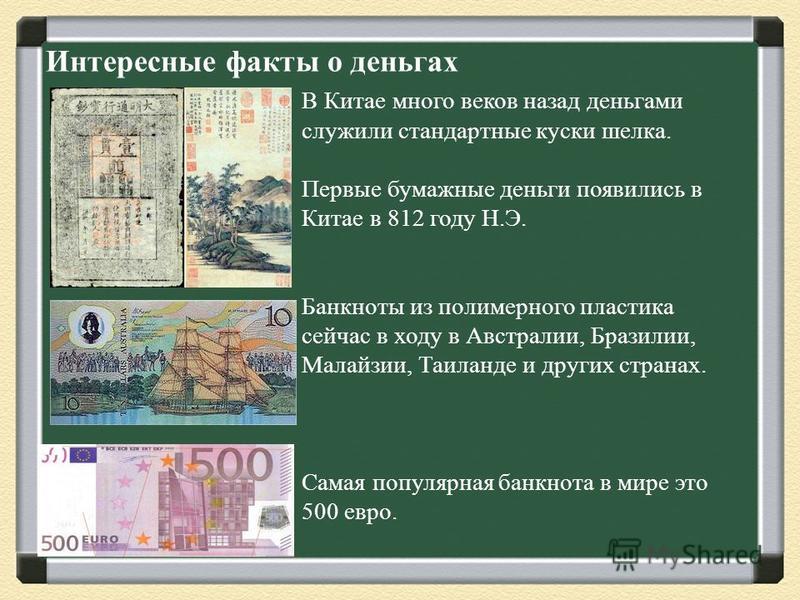
Interesting facts about money Frank H. McNamara became the inventor of the credit card after he did not have enough funds after dinner with friends. This is how Diners Club appeared. The first ruler who ordered to mint his person on coins was Alexander the Great.
Interesting facts about money The monetary unit of Botswana (Africa) pula is translated as "rain". Also the word pula is a greeting in one of the languages of this arid country. On the Yap Islands in the Pacific Ocean, for a long time, the function of money was performed by huge stone coins with a hole in the center “rai”. The largest stones reached 3 meters in diameter and weighed 4 tons, therefore, when buying them, they were often not moved from place to place, but simply wrote the name of the new owner on them. Today, these stones retain their symbolic meaning for the locals as attributes of wealth. The English king Henry VIII instead of making silver shillings began to mint them from copper, then covering them with silver. The silver quickly wore off, especially on the most protruding parts, which included the king's nose. Because of this, the king received the nickname "old copper nose".
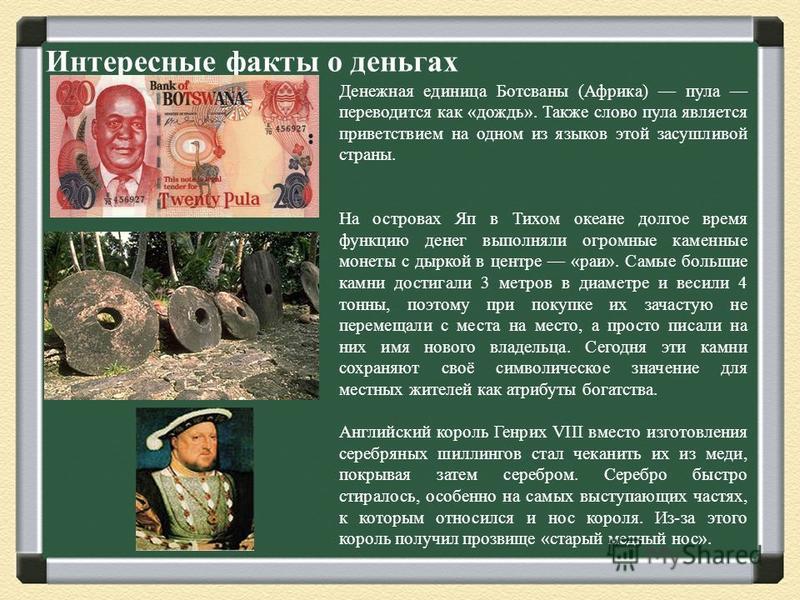
Interesting facts about money According to experiments, there can be several hundred thousand microbes on one banknote. Tip #1: Wash your hands often! Ordinary coins regulate the course of the world's most famous Big Ben clock in London! If the clock moves forward, then the head clock keeper puts a onepence coin on the pendulum, which subtracts a second! A coin is used by football referees when choosing a goal before a game. In Japan, the bells of peace were cast from coins collected by children. One of them is in New York.

Interesting facts about money Near the temple of Juno on the Capitol there were workshops where metal money was minted. That is why we call them coins, and in English the common name of money “money” came from this title. In medieval England, the word "pygg" was a type of clay from which household utensils were made. People often kept their savings in pots made of such clay and called them "pygg jar". Over time, the term turned into “pig bank”, and thanks to this consonance, piggy banks began to be made exclusively in the form of a pig.
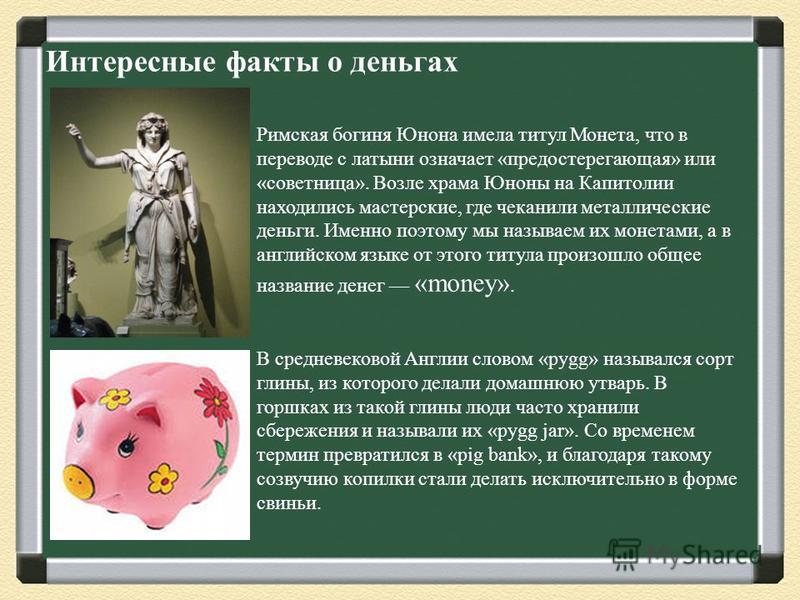
Interesting facts about money Initially, the largest weight and monetary unit in ancient Greece, Babylon, Persia and other areas of Asia Minor was called talent. From the gospel parable about a man who received money and buried it, being afraid to invest in a business, there was an expression "to bury talent in the ground." In modern Russian, this expression has acquired a figurative connotation due to the new meaning of the word talent and is used when a person does not care about developing his abilities.
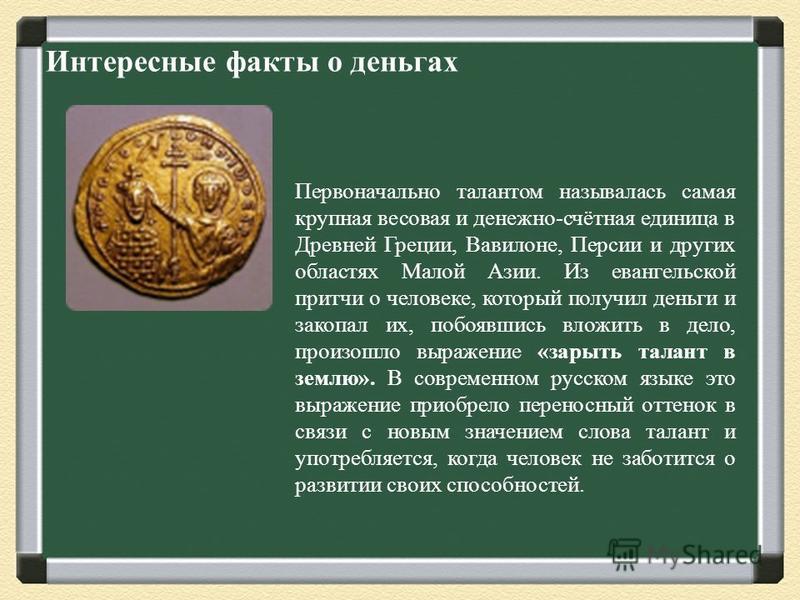
Interesting facts about money The most unusual material for money was the skin of seals. The Russian-American company at the beginning of the 19th century put into circulation 10 thousand monetary units in the amount of 42 thousand rubles. Until 1826, this money was in circulation. At the moment, one of these coins is worth as much as a piece of gold equal to it in weight.
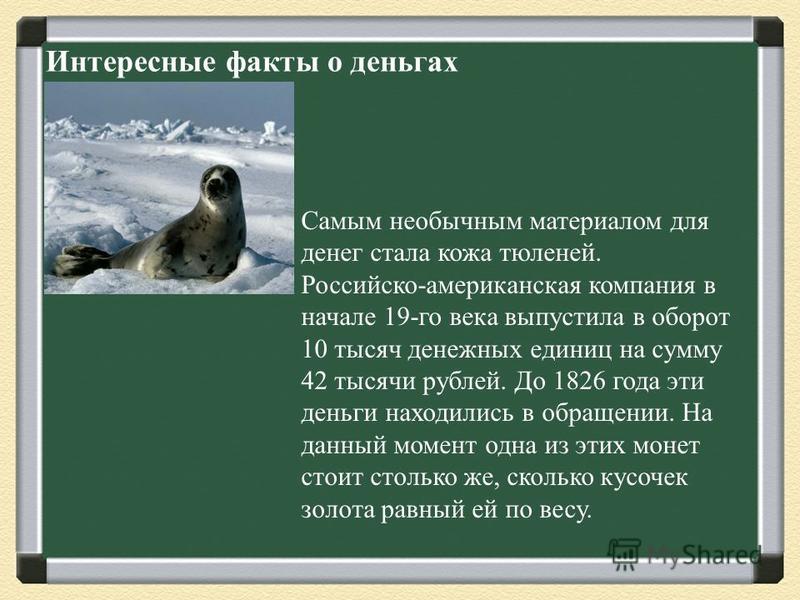
Interesting facts about money There is a funny version of why coins have ribbed edges. Previously, all coins had a denomination equal to the amount of gold or silver contained in them. The solution to the problem was proposed by Isaac Newton, who was part-time employee of the British Royal Mint. Fraudsters took advantage of this by trimming the edges of the coins, thus reducing their denomination. Of course, the scraps were sent for remelting. That is why the ribbed edges of the coins subsequently eliminated this type of fraud. This part on the coins is made in this way to this day and is called the edge.
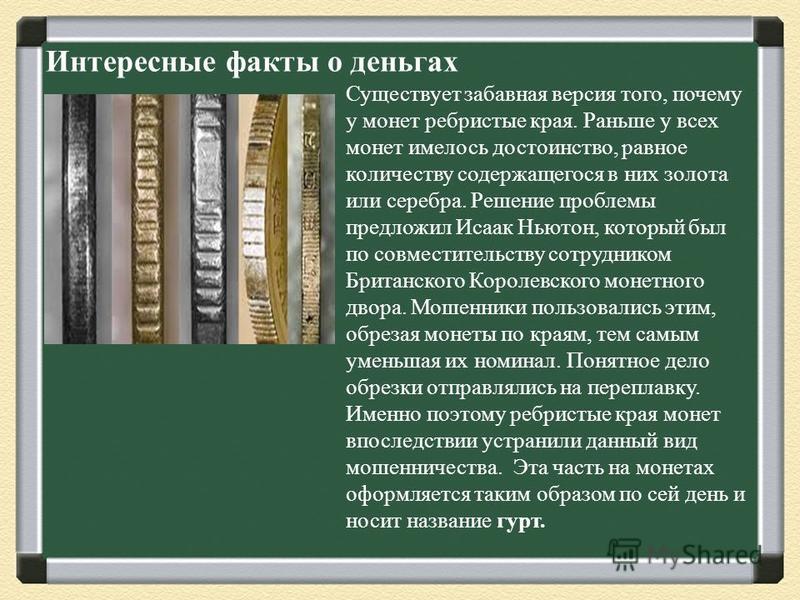
Interesting facts about money Indian banknotes always have pin holes in the left margin. They arise because in this country it is customary to stitch banknotes in bundles. Previously, they were stitched with threads. The most common currency is the franc. Francs are calculated in 34 countries of the world. Kuna, the monetary unit of Ancient Russia, which was in circulation until the end of the 14th and beginning of the 15th centuries. The term comes from the name of marten fur, which was in circulation as an exchange value in the centuries. Today the monetary unit in Croatia.
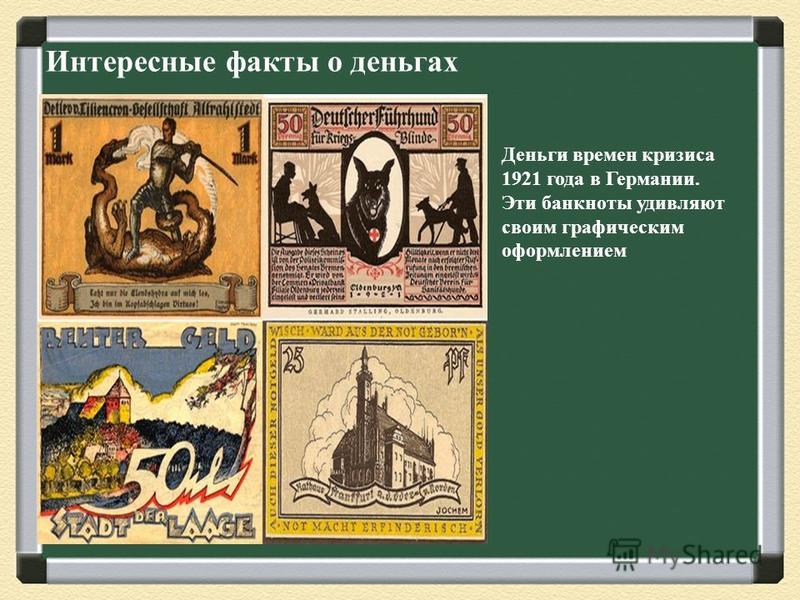
The history of electronic money At the turn of the 19th and 20th centuries, vending and slot machines, as well as traveler's checks, appeared. In 1906, Charles Kettering invented the electronic cash register, whose name is associated both with the invention of the automatic starter for automobile engines and with the first engine-powered generator.
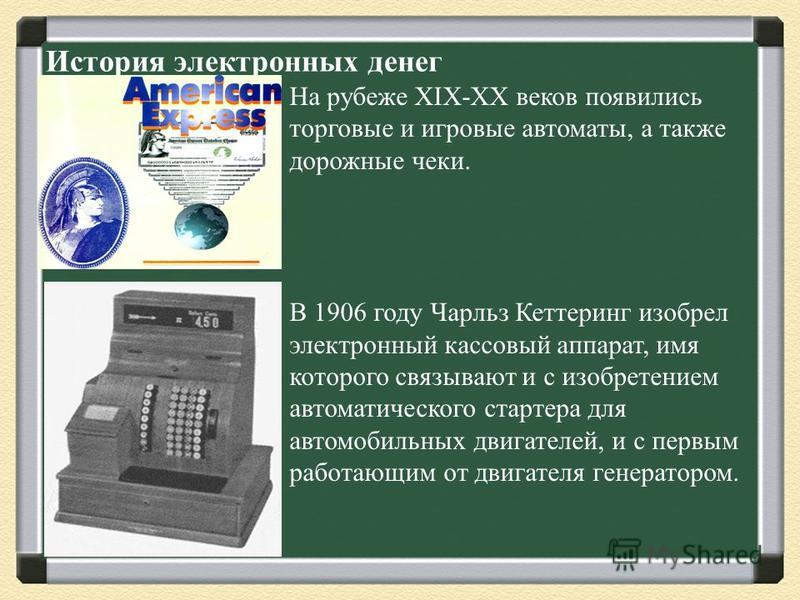
The history of electronic money In 1918, the US Federal Bank first transferred money through the telegraph. This is how the first electronic money appeared. In 1920, the first collection vehicle appeared. In 1937, the first loan was issued in the United States. In 1939, the first ATM appeared! The first cash dispenser was installed on June 27, 1967 in the Enfield area in north London (UK) in a branch of the British bank Barclays.

The History of Electronic Money In 1950, Frank McNarma issued the world's first credit cards to his customers. In 1974, Roland Moreno patented the first microprocessor called the "smart card", which allowed information to be exchanged with a central computer. Four years later, Dan Bricklin revolutionized accounting with his spreadsheets that inspired today's Excel.
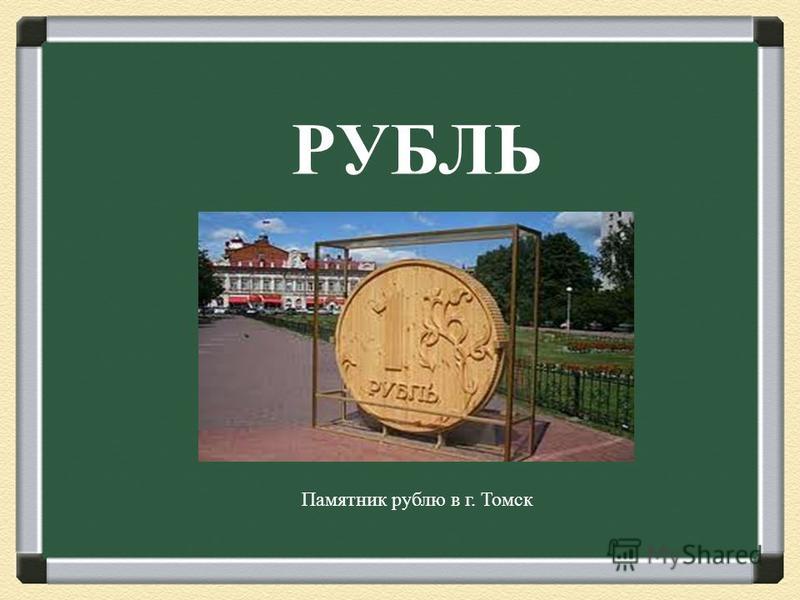
The origin of the word "ruble" The word "ruble" appeared in the XIII century for the name of "short, humpbacked ingots" hryvnia. The hryvnia was chopped and hence the word "ruble" appeared. At that time, the ruble was a counting unit, and in 1654 (according to other sources in 1704) the ruble became a coin for the first time. Konstantinovsky ruble. It is considered the most famous Russian coin. Only six complete test copies were made.
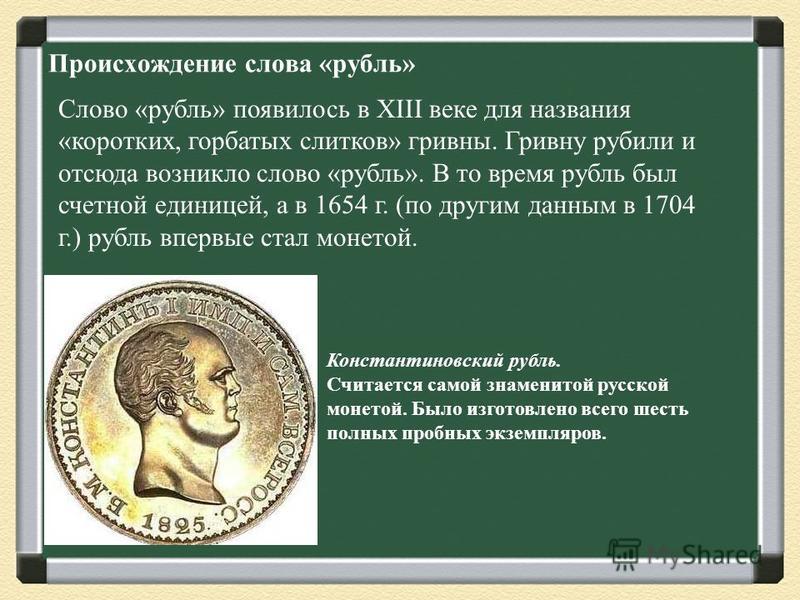
History of Russia The first equating of 1 ruble to 100 kopecks took place in Russia in 1704. Before that, there was no exact ratio of money. During the monetary reform of 1535 in Russia, the image of a rider with a saber on the coins was replaced by the image of the Grand Duke with a spear. On an old Russian silver kopeck, George the Victorious was depicted with the same spear. Later, such coins were called kopecks. The word "penny" appeared under Ivan the Terrible. At that time, silver coins were printed with the image of a prince with a spear in his hand. that's where "spear money" came from. The smallest coin in Russia was a "half", it was equal to 1/8 kopeck. However, there were also coins with the original name "flakes". In the 13th century, the hryvnia was the monetary and weight unit in Russia, divided into 4 parts (“ruble”). A particularly weighty remnant of the ingot was called the "long ruble". These words are connected with the expression about big and easy earnings “chasing a long ruble”.
History of Russia Coins of small denominations were a great inconvenience for people. Even M.V. Lomonosov himself, who once received an award of 2 thousand rubles, felt them for himself. The weight of this premium amounted to more than three tons. During the entire existence of the Soviet Union, the only gold coin was the Soviet chervonets. It is noteworthy that it was also the only hard currency in the entire Soviet history. The first such items were minted in 1923 and were produced until the 80s.

Zlatnik, gold, weight 4.15 g. After the adoption of Christianity in 988, by minting such first gold coins, Russia declared the sovereignty of its state. The weight of the zlatnik for a long time became the Russian unit of weight called the spool. Russian history

The largest coin was minted during the reign of Catherine I in 1725. Its size was 18 by 18 centimeters, thickness 5 millimeters. The weight of the coin was serious: 1 kilogram 636 grams. In the history of modern Russia, the largest silver coin weighing 3 kilograms was issued in 1999. Russian leather money issued by the Russian-American Company in Alaska in 1816, 1826 and 1834.
History of Russia In 1897, Russia, on the initiative of the Minister of Finance S.Yu. Witte almost lost the ruble as a monetary unit. He proposed to put into circulation a new currency with the name "Rus" or "Rus". In 1919, an attempt was made in Russia to put into circulation very specific money called "sovznaki". They were matchbox-sized credit notes and looked more like large stamps. They were printed on one sheet of 25 pieces, so that if necessary, bills had to be cut off from the sheets.
Peculiarities of Russian banknotes All banknotes have a single style and character of compositional design. The theme of design and size of the new banknotes did not change and retained the plot images of sightseeing places and monuments of Russia. Bank notes are printed on high quality, hard, crisp paper. Such paper withstands up to kinks in the same place. For each denomination, paper with an individual color shade is used.

